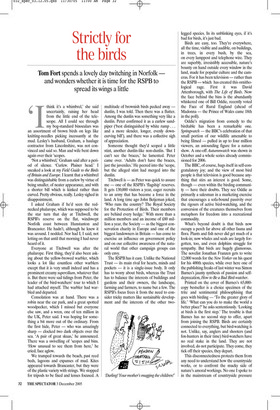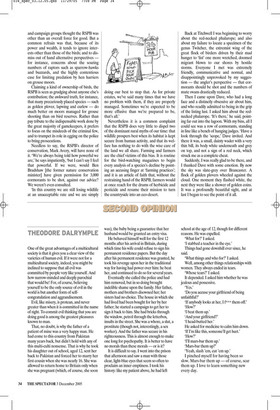Strictly for the birds
Tom Fort spends a lovely day twitching in Norfolk — and wonders whether it is time for the RSPB to spread its wings a little ‘I think it’s a whimbrel,’ she said uncertainly, raising her head from the little end of the telescope. All I could see through my bog-standard binoculars was an assortment of brown birds on legs like knitting-needles picking incessantly at the mud. Lesley’s husband, Graham, a haulage contractor from Lincolnshire, was not convinced and said so. Man and wife bent down again over their ’scopes.
‘Not a whimbrel,’ Graham said after a period of silence. ‘Curlew. Plainer head.’ I sneaked a look at my Field Guide to the Birds of Britain and Europe. I learnt that a whimbrel was distinguishable from a curlew by virtue of being smaller, of neater appearance, and with a shorter bill which is kinked rather than curved. Pretty obvious, really. Lesley sighed in disappointment.
I asked Graham if he’d seen the rednecked phalarope, which was supposed to be the star turn that day at Titchwell, the RSPB’s reserve on the flat, windswept Norfolk coast between Hunstanton and Brancaster. He hadn’t, although he knew it was around. I nodded. Nor had I, I said, not letting on that until that morning I had never heard of it.
Everyone at Titchwell was after the phalarope. First thing, they’d also been asking about the yellow-browed warbler, which looks a lot like countless other warblers except that it is very small indeed and has a prominent creamy supercilium, whatever that is. But there were sad tidings from Peter, the leader of the bird-watchers’ tour to which I had attached myself. The warbler had warbled and departed.
Consolation was at hand. There was a robin near the car park, and a great spotted woodpecker, which I missed but everyone else saw, and a wren, one of ten million in the UK, Peter said. I was hoping for something a bit more out of the ordinary. From the first hide, Peter — who was amazingly sharp — clocked two dark objects over the sea. ‘A pair of great skuas,’ he announced. There was a swivelling of ’scopes and bins. ‘How unusual to see them from here,’ he cried, face aglow.
We tramped towards the beach, past reed beds, lagoons and expanses of mud. Kites appeared towards Brancaster, but they were of the plastic variety with strings. We stopped for tripods to be fixed and lenses focused. A multitude of brownish birds pecked away dunlin, I was told. Then there was a flutter. Among the dunlin was something very like a dunlin. Peter confirmed it as a curlew sandpiper (‘best distinguished by white rump ... and a more slender, longer, evenly downcurving bill’), and there was a collective sigh of appreciation.
Someone thought they’d scoped a little stint, another dunlin-like non-dunlin. ‘But I can’t see the braces,’ he lamented. Peter came over. ‘Adults don’t have the braces, just the juveniles.’ He peered into the ’scope, but the alleged stint had merged into the dunlin.
Titchwell is — as Peter was quick to assure me — one of the RSPB’s ‘flagship’ reserves. It gets 130,000 visitors a year, eager recruits to an army that has become a force in the land. A long time ago John Betjeman joked, ‘Who runs the country? The Royal Society for the Protection of Birds. Their members are behind every hedge.’ With more than a million members and an income of £80 million a year, the Society — as the biggest conservation charity in Europe and one of the biggest landowners in Britain — has come to exercise an influence on government policy and on our collective awareness of the natural world that other campaign groups can only envy.
The RSPB has it easy. Unlike the National Trust — its main rival for hearts, minds and pockets — it is a single-issue body. It only has to worry about birds, whereas the Trust has to balance the interests of buildings and gardens and their owners, the landscape, farming and farmers, to name but a few. The RSPB’s focus frees it from the need to consider tricky matters like sustainable development and the interests of the other two legged species. In its unblinking eyes, if it’s bad for birds, it’s just bad.
Birds are easy, too. They’re everywhere, all the time, visible and audible, on buildings, in trees, in every bush, by the sea, on every lamppost and telephone wire. They are superbly, irresistibly accessible, nature’s bounty on hand outside every window in the land, made for popular culture and the cameras. For it has been television — rather than the RSPB — which has created this ornithological rage. First it was David Attenborough, with The Life of Birds. Now the face behind the bins is the abundantly whiskered one of Bill Oddie, recently voted the Face of Rural England (ahead of Madonna — the Prince of Wales came 18th in the poll).
Oddie’s migration from comedy to the birdtable has been a remarkable one. Springwatch — the BBC’s celebration of that small portion of our wildlife amenable to being filmed — pulled in up to four million viewers, an astounding figure for a nature show. A one-off Autumnwatch was shown in October and a whole series already commissioned for 2006.
The BBC, of course, hugs itself in self-congratulatory joy; and the view of most bird people is that television is good because anything that stirs an interest is good. Some, though — even within the birding community — have their doubts. They see Oddie as primarily a salesman in a marketing exercise that encourages a sofa-bound passivity over the rigours of active bird-watching, and the conversion of the creatures themselves from metaphors for freedom into a recreational commodity.
What’s beyond doubt is that birds now occupy a perch far above all other fauna and flora. Plants and fish never did get much of a look-in; now whales and seals are largely forgotten, too, and even dolphins struggle for sympathy. But birds are hugely glamorous. The novelist Jonathan Franzen gets to write 12,000 words for the New Yorker on his quest for his 400th species, while over here one of the publishing freaks of last winter was Simon Barnes’s jaunty synthesis of passion and selfdeprecation, How to Be a Bad Bird-watcher.
Printed on the cover of Barnes’s 65,000copy bestseller is a choice specimen of the trite and sentimental philosophising that goes with birding — ‘To the greater glory of life.’ ‘What can you do to make the world a better place?’ he asks sententiously. ‘Looking at birds is the first step.’ The trouble is that Barnes has no second step to offer, apart from joining the RSPB. Birds are certainly connected to everything, but bird-watching is not. Unlike, say, anglers and shooters (and fox-hunters in their time) bird-watchers have no real stake in the land. They are not involved, do not participate. They come, they tick off their species, they depart.
This disconnectedness protects them from any need to understand how the countryside works, or to confront the mucky side of nature’s amoral workings. No one I spoke to in the mainstream of countryside pressure and campaign groups thought the RSPB was other than an overall force for good. But a common refrain was that, because of its power and wealth, it tends to ignore interests other than those of the birds; and to dismiss out of hand alternative perspectives for instance, concerns about the soaring numbers of raptors such as sparrow-hawks and buzzards, and the highly contentious case for limiting predation by hen harriers on grouse moors.
Claiming a kind of ownership of birds, the RSPB is seen as grudging about anyone else’s contribution; the awkward truth, for instance, that many precariously placed species — such as golden plover, lapwing and curlew — do much better on moors managed for grouse shooting than on bird reserves. Rather than pay tribute to the indispensable work done by the great majority of gamekeepers, it prefers to focus on the misdeeds of the criminal few, and to trumpet its role in egging on the police to bring prosecutions.
Needless to say, the RSPB’s director of conservation, Mark Avery, will have none of it. ‘We’re always being told how powerful we are,’ he says impatiently, ‘but I can’t say I feel that powerful. If we were, would Ben Bradshaw [the former nature conservation minister] have given permission for 3,000 cormorants to be shot, against our advice? We weren’t even consulted.
‘In this country we are still losing wildlife at an unacceptable rate and we are simply doing our best to stop that. As for private estates, we’ve said many times that we have no problem with them, if they are properly managed. Sometimes we’re expected to be more effusive than we’re prepared to be, that’s all.’ Nevertheless it is a common complaint that the RSPB does very little to dispel two of the dominant rural myths of our time: that wildlife prospers best when its habitat is kept secure from human activity, and that its welfare has nothing to do with the wise care of the land we all share. Farming and farmers are the chief victims of this bias. It is routine for the bird-watching magazines to begin every analysis of a species’s decline by pointing an accusing finger at ‘farming practices’; and it is an article of faith that, without the restraining hand of the RSPB, farmers would at once reach for the drums of herbicide and pesticide and resume their mission to turn the countryside into an eco-desert. Back at Titchwell I was beginning to worry about the red-necked phalarope; and also about my failure to locate a specimen of the genus Twitcher, the extremist wing of the great flock of birders driven by their mad hunger to ‘list’ one more wretched, doomed migrant blown to our shores by hostile storms. Everyone I met was extremely friendly, communicative and normal, and disappointingly unprovoked by my suggestion — the angler’s perspective — that cormorants should be shot and the numbers of mute swans drastically reduced.
Then I came upon Dave, who had a long face and a distinctly obsessive air about him, and who readily admitted to being in the grip of the listing lust. I asked him about the rednecked phalarope. ‘It’s there,’ he said, pointing far out into the lagoon. With my bins, all I could see was a row of cormorants, standing in line like a bench of hanging judges. ‘Have a look through the ’scope,’ Dave invited. And there it was, a small, dainty wader with a very thin bill, its body white underneath and grey on top, and not a sign of a red neck, which struck me as a complete cheat.
Suddenly, I was really glad to be there, and I thanked Dave with some emotion. By now the sky was slate-grey over Brancaster. A flock of golden plovers wheeled against the cloud. One moment they flashed white, the next they were like a shower of golden coins. It was a profoundly beautiful sight, and at last I began to see the point of it all.




























































 Previous page
Previous page